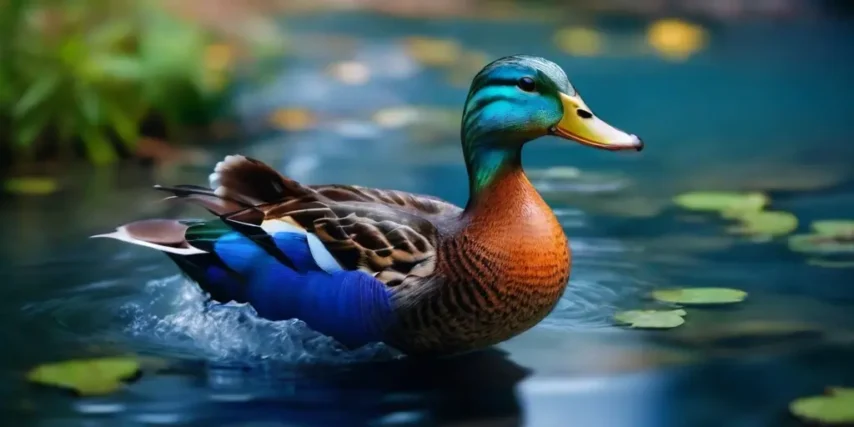The Hydrophobic Magic: Unraveling the Secrets Behind Ducks’ Waterproof Feathers
Ducks, those charming and ubiquitous waterfowl, are not only admired for their quirkiness but also for their remarkable ability to stay dry even in the wettest conditions. The secret lies in their feathers, a marvel of nature’s engineering that has fascinated scientists and bird enthusiasts alike. In this article, we will delve into the intricate world of ducks’ waterproof feathers, exploring the evolutionary marvels, structural features, and the scientific magic that makes them virtually impervious to water
Evolutionary Adaptations:
The ability of ducks to thrive in aquatic environments is deeply rooted in the process of natural selection. Over millions of years, as these birds adapted to life in and around water, their feathers underwent significant evolutionary changes to enhance their waterproofing capabilities.
One key adaptation is the development of an intricate feather structure. Unlike many land birds, ducks have a dual-layered feather system. The outer layer, known as the contour feathers, is responsible for providing shape and color to the bird. The inner layer, called down feathers, plays a crucial role in insulation, keeping the duck warm in cold water. Together, these layers create a formidable barrier against water penetration.

Hydrophobicity at its Finest:
At the heart of the ducks’ waterproofing prowess lies the hydrophobic nature of their feathers. Hydrophobicity refers to the tendency of a material to repel water. This remarkable trait is achieved through a combination of structural features and the presence of special oils.
Microscopic examination of duck feathers reveals a complex structure of interlocking barbs and barbules. These structures create a dense mat, akin to a tightly woven fabric, which prevents water from penetrating through to the skin. Additionally, the surface of the feathers is covered in a layer of microscopic projections that further enhance water repellency.
The Role of Uropygial Gland:
To maintain their feathers’ hydrophobicity, ducks rely on a specialized gland known as the uropygial gland, or preen gland. Located at the base of the tail, this gland produces an oily, waxy substance that the ducks spread over their feathers during preening. This substance, known as preen oil, not only helps to keep the feathers flexible but also adds an extra layer of waterproofing.
Preen oil is composed of a complex mixture of lipids, including fatty acids and preen-specific proteins. When a duck runs its beak through its feathers during preening, it distributes this oil evenly across the plumage, reinforcing the hydrophobic barrier. The result is a feather coat that effectively sheds water, keeping the duck dry even in the most adverse weather conditions.

Biological Inspiration for Human Technology:
The marvel of ducks’ waterproof feathers has not gone unnoticed by scientists and engineers. The field of biomimicry, which draws inspiration from nature to solve human challenges, has looked to ducks for insights into creating water-resistant materials.
Researchers studying the structure of duck feathers have sought to replicate their hydrophobic properties in various applications. From waterproof clothing to building materials, the lessons learned from ducks’ feathers are inspiring innovations that could revolutionize how we interact with water in our daily lives.
Challenges and Threats to Waterproofing:
While ducks have evolved to master the art of repelling water, they are not entirely free from challenges. Pollution, habitat loss, and human disturbances can compromise the effectiveness of their waterproofing mechanisms. Oil spills, in particular, pose a significant threat, as they can disrupt the delicate balance of the uropygial gland’s secretions.
Conservation efforts aimed at preserving wetland habitats and mitigating human impact on waterfowl environments are crucial for ensuring the continued success of ducks and their remarkable waterproofing adaptations. By understanding and appreciating the intricate mechanisms at play, we can work towards safeguarding these avian wonders for generations to come.
Conclusion:
Ducks’ waterproof feathers stand as a testament to the marvels of evolution and the ingenuity of the natural world. From the microscopic structures that create a waterproof barrier to the secretions of the uropygial gland that maintain this hydrophobicity, every aspect of ducks’ feathers is a lesson in survival and adaptation.

As we unravel the secrets behind ducks’ waterproof feathers, we not only gain a deeper appreciation for the intricacies of nature but also find inspiration for solving some of our own challenges. The intersection of biology and technology, as seen in the study of hydrophobic materials, opens doors to innovations that could reshape industries and improve our quality of life.
So, the next time you marvel at a duck gliding effortlessly across a pond, take a moment to reflect on the wonders of its waterproof feathers. It’s a reminder that in the natural world, even the seemingly mundane can hold the keys to extraordinary discoveries.







